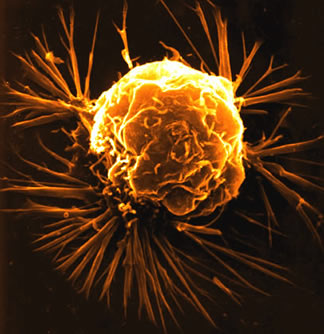Rachel Ehrenber, Science News
Published Tuesday October 9, 2012
http://www.sciencenews.org/view/generic/id/345663/description/Cancer_cells_executed_by_magnet
Summary:
The ongoing war between humans and cancer has been going on for a few years now- roughly 4000 years to be exact. Since the first recorded case of cancer back when years were counted down (a.k.a Before the Common Era) to the cancer victim in a hospital near you, cancer has been inflicting pain upon its victims and puzzling scientists. There has always been this question :How can one effectively kill cancer? The methods known to us today are surgery, chemotherapy, and radiotherapy. Each one is not perfectly sure to work, and each one has undesirable side effects, making them a very dreadful experience. On the other hand, this article tells of a new method of removing cancer cells- self destruction. Scientists have now discovered a new method using magnets to turn on the self destruct "button" on a cell, effectively killing them. Scientists have found a way to lead the nanoparticles to something called "death receptor 4". This is a "switch" on the outside of a cell that, if activated (by the clumping of nanoparticles), it can completely demolish the cell. In South Korea, this new method was tested on a dish of colon cancer cells, and within 24 hours, more than half the cells exposed to the magnetic field (coming from the magnet) were dead. Of course, there is also a con to this method. See, normal cells of your body also contain death receptor 4, which leads to the problem that in order to kill off the cancerous cells, normal cells must also be demolished in the process. When tested on zebra fish, their tails had a small indentation where death receptor 4 was activated, showing that it is not a very safe process to test out. It is still unknown whether or not the magnet can be aimed so that it specifically kills the cancerous cells. There seem to be many factors that might effect the efficacy of the magnet.

Connection:
In Biology Class, we are currently learning about cancer cells and how cancer could possibly be treated. The three methods that the book provides are surgery (removing the malignant tumors), radiotherapy (exposing parts of the body to high- energy radiation, and chemotherapy (treating the patient with drugs that disrupt cell division). This links to what we are learning because it is a possible new method of successfully removing cancer cells without the unwanted side effects that radiotherapy and chemotherapy bring. It is also much more precise and more likely to succeed than surgery. So, overall, this new discovery provides a possible new cure for cancer in the near future.
Picture: http://www.news-medical.net/image.axd?picture=2009%2F12%2Fbreast+cancer+cell.jpg
Are the magnets extremely strong or weak? (I would assume if they were stronger, then it might affect the whole body, but if it was weak, wouldn't also not work?) and do you think this is the best process that we know of so far?
ReplyDeleteWell, the article does not actually say. But, if I had to make an inference, I would guesstimate that the magnet would be pretty strong but very focused. This means that the magnet would be strong enough to cause all of the cells in a certain area (of course that are not resistant to it already) to kill themselves, but I assume that the area would not be large enough to literally kill off every single cell of your body. And personally, as of now, it seems like a good plan....... that is if the scientists manage to target only the cancer cells. Weird thing is that the article doesn't tell of any side effects (other than destruction of normal cells), so I think that it should be a very effective method of getting rid of cancer, given it is controlled. It isn't as painful for the "victim".
DeleteOut of curiosity, do we know which of our cells specifically have death receptor 4? Also, does the "4" imply that there are other similar "self destruct buttons"?
ReplyDelete(And how is 4000 years "a few years"?)
The article doesn't actually specifically say, but it says so in a vague manor. After actually trying to find which cells specifically have death receptor 4, I couldn't really find anything about which cells contain it. But, in the article, it says "Death receptor 4 sits on normal cells too", which leads me to infer that it is on every cell, although that might not be the case. As for your second question, there are other death receptors, such as death receptor 3, death receptor 5, death receptor 6, and Fas receptor. (As for your third question..... idk).
Delete